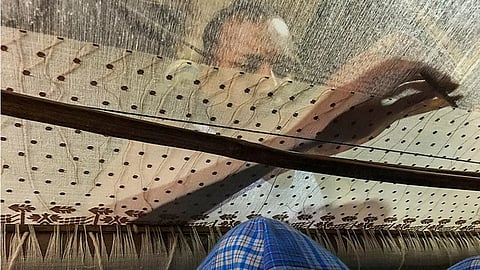
- HOMEGROWN WORLD
- #HGCREATORS
- #HGEXPLORE
- #HGVOICES
- #HGSHOP
- CAREERS
- ABOUT US
- CONTACT US

In the 18th century, Europe’s royal courts were mesmerised by whispers of a legendary textile that was so fine, it was practically indistinguishable from the thin layer of dew that gathers on blades of grass on early winter mornings. Known as ‘baft-hawa’ or ‘woven air’, this ethereal fabric was a favourite of French Queen Marie Antoinette, Empress Joséphine Bonaparte, and English author Jane Austen, and said to be made by fairies in the mystic forests of India.
In reality, this was ‘Muslin’ — a fine, handspun, gossamer-like fabric made from a rare cotton plant known as ‘phooti karpas’ (Gossypium arboreum var. neglecta) by women weavers of Jangalbaree, Shonagragon, Teetbari, Dhamrai, and Bajitpur villages near Dhaka, in modern-day Bangladesh. According to one 19th century Arabian traveller, this fine muslin was so fluid you could pull a bolt — a length of 300 feet, or 91 metres — through the centre of a ring.
Muslin gets its name from the town of Mosul in modern-day Iraq. In the 12th century, Arab traders took fine, handwoven fabrics made in Mosul to Europe where it became popular as “Muslin” or fabric “from Mosul”. But long before Mosul, women weavers in the Bengal region — now divided across modern-day India and Bangladesh — were making even softer, finer cotton fabrics known variously as ‘Shabnam’ (fabric as fine as morning dew), ‘Abrawan’ (a fluid, transparent, water-like textile), ‘Nayansukh/Tansukh’ (pleasure of the eyes/body, a legendary fabric mentioned in the Ain-e-Akbari), and ‘Jamdani’ (a fine, lightweight handspun cotton fabric with embroidered floral motifs and patterns).
In the Mughal period, Jamdani became the most popular muslin fabric in South Asia. While its origins remain shrouded in mystery, we know from mentions of it in Mughal documents that a cottage industry producing high quality Jamdani was well-established in the Bengal region by the time of the Mughals. The fine, handspun, handwoven, and hand-embroidered textiles made here were known as ‘Jamdani’ because of their distinctive floral motifs and got the name from the Farsi words ‘jam’, meaning ‘flower’, and ‘dani’, meaning ‘vase’.
Jamdani is a vividly patterned, sheer cotton fabric, traditionally woven on a handloom by craftspeople and apprentices around Dhaka. Jamdani textiles combine intricacy of design with muted or vibrant colours, and the finished garments are highly breathable. Jamdani is a time-consuming and labour-intensive form of weaving because of the richness of its motifs, which are created directly on the loom using the discontinuous weft technique.
Light as a feather, and transparent like water, Jamdani fabrics were supposedly a favourite of the Mughal poet-princess Zeb-un-Nissa. Even during the Mughal period, these textiles were prized possessions cherished by royalties and aristocrats. The Jagath Seth family — the bankers to Mughal emperors in Delhi and Murshidabad’s Nawabs — were also in the Muslin trade and believed to have owned two lengths of Jamdani Muslins, 12 yards long and one yard wide with thread counts between 600 and 1000, which only weighed 7 ounces or just over 200 grams.
When the Europeans first arrived in India, they were astonished not only by the quality and diversity of India’s indigenous cotton textiles, but also by its extensive trade networks which exported these textiles as far as China and Europe through the Silk Road. Soon, however, the Europeans took over these trade networks, and Indian textile exports to Europe grew exponentially, with Bengal being the largest contributor. At one point in the late 18th century, Indian textiles accounted for almost 70% of the British East India Company’s exports and they started exploiting the farmers and the weavers by regularly lowering their purchase price and taxing exports.
By the 19th century, Britain became the largest producer and exporter of cheaper, mass-produced textiles to India, and the value of Bengal Muslin diminished rapidly. The cotton farmers, and those involved in the spinning, dyeing, weaving and production of Muslin gradually lost their means of livelihood and moved on to other occupations. As a result, the once-lucrative Indian textile industry dwindled. Within years, the Muslin industry was reduced to a shadow of its former, glorious self.
And yet, the legendary Jamdani textile survived. From Dhaka, the centre shifted to Tangail — on the banks of Brahmaputra — where the Basaks continued to produce handspun, hand-dyed, handwoven, and hand-embroidered Jamdani textiles. Here, the textile became popular as ‘Tangail Taant’ or simply the ‘Tangail textile’ after its new terroir.
After the Partition of India in 1947, most of the traditional weavers, including most of the Hindu Basak community, migrated from East Pakistan (now Bangladesh) to West Bengal in India. This process of migration intensified in 1965 and reached its peak in 1971, during the India-Pakistan War and the Bangladesh Liberation War. With these weavers and artisans, the textile tradition, too, migrated to India where it thrived in Nadia and Murshidabad. In Phulia, the Basaks began producing textiles following the same techniques from Tangail. Although the textiles produced here were not as fine or transparent as the classical Jamdani made in Dhaka and Tangail, these new weaving clusters helped preserve the Jamdani textile tradition. In January 2024, West Bengal received the coveted Geographical Indication (GI) tag for 'Tangail Saree of Bengal'.
In recent years, the Bangladesh Government, too, has been working to resurrect the legendary Dhakai Muslin. In 2013, Bengal Muslin — a collaboration between Drik, an independent media organisation, the Bangladesh National Museum, and Aarong, a crafts NGO — rediscovered a cultivar of the 'phuti karpas' plant with as much as 70% match with archival samples of the original plant. In 2021, they were able to produce Muslin fabric with thread counts in the high hundreds. But does that mean the legendary fabric once known as woven air is back?
Only time will tell.
